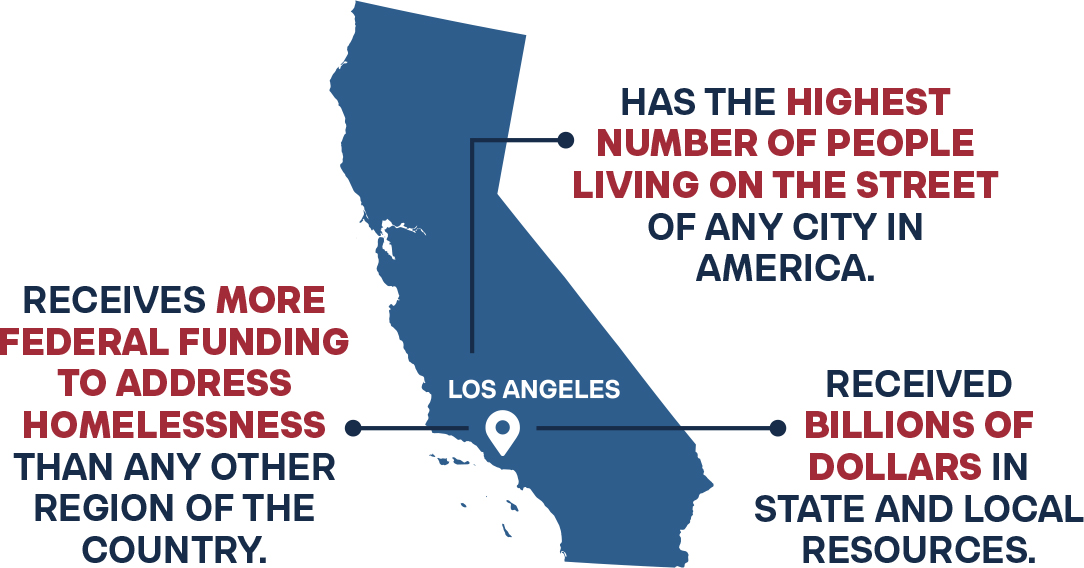
Consolidating the Continuum of Care Program at the U.S. Department of Housing and Urban Development
Introduction
Homelessness in America reached the highest levels on record in 2024, according to the U.S. Department of Housing and Urban Development’s (HUD) Annual Homeless Assessment Report.1 The clamor for reform among policymakers and the public has grown steadily over the last five years. Voters are pushing back on failing homelessness policies, passing referendums that penalized municipalities for failing to clear encampments in Phoenix, Arizona, creating pathways to compel treatment for chronic drug offenders in California, and reinstating prohibitions against street camping in Austin, Texas.2,3,4 National polls have found more than 70 percent of voters from both parties support policies that fall outside of current HUD practices, such as requiring sobriety and treatment as a condition of receiving publicly funded housing.5 State policymakers are paying attention to these political tremors, as Florida, Georgia, Idaho, Kentucky, Mississippi, Oklahoma, Tennessee, and Utah, to name a few, have all taken steps to break from the federal homelessness policies that they see as contributing to the growing humanitarian crisis on America’s streets.6
Yet, despite the unusually broad political consensus on the need for a new approach to homelessness, the pathway to reform is not as clear as it could be. The structure of federal homelessness funding from HUD is rife with perverse incentives, opportunities for corruption, and obstacles to public accountability and transparency, which are described in detail below.
For homelessness policy to shift nationwide, HUD must go beyond reprioritizing certain types of programs. HUD must overhaul the entire structure of its hallmark homelessness funding mechanism: the Continuum of Care (CoC) program. Specifically, it must empower state governments to lead the Continuums of Care and create a proper check and balance on the nonprofits and local agencies that typically govern CoCs with impunity.
What is the Continuum of Care Program?
Nationwide, more than 400 regional planning organizations oversee the dispersal of federal homelessness funding to service providers for data collection, housing, and homelessness intervention strategies.7 These organizations, called Continuums of Care (CoC), are not government entities, nor is their leadership accountable to the public. Instead, they are private umbrella organizations composed of nonprofit service providers, local housing or public health agencies, and other relevant stakeholders.
Communities began forming CoCs in earnest following a 2009 change to HUD policy, which prioritized funding to the communities in which they existed. In order to remain competitive for federal support, local leaders were forced to adopt this regional planning and coordination regime.8 These newly formed CoCs would represent an entire community’s application for funding, using what is now called a collaborative application.9 Homeless service providers apply for federal funding through the CoCs, rather than individually, which was initially seen as a more direct funding process.
But the CoCs have become major obstacles for local, state, and regional policymakers looking to reform homelessness programs. Because so much power and financial resources are vested in these organizations that are often outside the direct control of elected officials, the CoC program is largely immune to state-level policy changes.
Structural Problems of the Continuum of Care Program
The U.S. Department of Housing and Urban Development was wrong to outsource so much decision-making about homelessness policy and strategy to CoCs, and it has led to four major problems. First, CoCs are unaccountable to voters; second, the collaborative application process led by CoCs create perverse incentives for organizations to act in their self-interest rather than the interests of the public; third, CoCs often give disproportionate voice to activists rather than the public; and finally, CoCs thwart cooperation with state policymakers.
Unaccountability
The governing boards of CoCs are unelected by the public and often consist of members of nonprofit organizations representing private interests.10 Even when CoCs include government officials, they typically represent municipal and county housing agencies and are outnumbered by non-profit representatives.
When the public seeks new approaches that reflect their values and priorities on homelessness, they ought to have a voice—and an avenue to share it. And if the public cannot vote directly, they should be able to vote for the people who appoint those who lead a community’s homelessness policies and make decisions about the utilization of public money. But the structure of a CoC is fundamentally antidemocratic, empowering coalitions of private organizations instead of elected officials.
The absence of state agencies and elected officials in the HUD CoC structure creates an environment in which the only oversight for many of these homeless programs comes from Washington, D.C., leaving voters and policymakers removed from decision-making that deeply affects their communities.
Perverse Incentives
Applications for federal homelessness funding are filed primarily through collaborative applications led by Continuums of Care.11 The problem with this process is that a new entrant into the homeless services space must first seek approval from incumbent service providers who lead the CoC for their region. In other words, the new organization must ask permission from its competitors to compete against them for federal funding. This structure incentivizes CoCs to maintain or grow funding for existing organizations and obstruct the diversion of funds to new organizations or programs, especially those that fall outside the preferred model or approach to homelessness of the other CoC organizations.
Inappropriate Activism
The broad inclusion criteria for the Continuums of Care empower activist organizations to exert unchecked influence on homelessness strategy and policy. The involvement of activist movements—promoting harm reduction and the idea that housing is a human right—has influenced the organizations responsible for managing homelessness resources (CoCs), shifting their original focus and making their work overly political. Instead of focusing solely on reducing the number of homeless people, CoCs take up a variety of causes such as opposing enforcement measures, prioritizing issues of sexual identity in housing, and advocating for more housing subsidies.
Lack of Cooperation
Because CoCs fall outside the authority of state governments, there is limited cooperation between state public health and safety agencies and homeless service providers. This is most true in the case of data sharing. The Homeless Management Information System (HMIS) is maintained by CoCs to collect data related to the delivery of homeless services.12 Only those agencies granted access by the CoCs have access to HMIS, and as a result, crucial information is siloed. For example, there is little data sharing between HMIS and law enforcement, despite law enforcement being eligible for access according to HUD regulations, or between HMIS and the sex offender registry.13 Even the Louisiana State Auditor’s office was unable to obtain HMIS data from the New Orleans Continuum of Care.14 The lack of transparency and cooperation of CoCs is unacceptable for organizations acting as custodians of billions of dollars in public funds and harms the coordinated deployment of services intended for the indigent.
Waste, Fraud, and Negligence
At best, the structural defects of the Continuum of Care program make it ineffective. At worst, they enable CoCs to waste public funds, resulting in the costly loss of the lives of homeless people. Communities are committing more and more money and resources to homelessness assistance, yet witnessing ever-increasing levels of homelessness, public disorder, and destitution.15 This has raised valid concerns that homelessness assistance resources are being wasted or even being used fraudulently, resulting in an alarming level of neglect toward people living on the street.
Los Angeles is a clear example, as it receives more federal funding to address homelessness than any other region of the country.16 It has also received billions of dollars in state and local resources.17 Yet, according to the Point in Time Count, LA has the highest number of people living on the street of any city in America, more than 50,000 in 2024.18 As a result of investigations, audits, and a federal lawsuit, it has become clear that LA’s inability to reduce the number of homeless people is due to an ineffective and unaccountable Continuum of Care.19 It has been found that the Los Angeles Homelessness Services Authority (LAHSA) tracks its revenue inadequately, made improper advances of tens of millions of dollars to service providers, has no reliable system to determine where money is going and what it is producing, and has little oversight or accountability for the hundreds of millions of dollars intended to serve the homeless.20

After eight audits and reviews of the agency since 2007, LAHSA is now the subject of a criminal investigation into waste, fraud, and abuse.21 Va Lecia Adams Kellum, the former CEO of the Los Angeles Homelessness Service Authority (LAHSA), earned $420,000 a year.22 The most recent audit showed a system in disarray, failing to track billions of dollars.23 Kellum resigned in response.24
In New York City, investigators found that City-funded programs that received millions regularly hired family members, vastly increased executive pay, and had significant financial mismanagement.25 An audit of homelessness programs in Arizona found inappropriate personal loans to employees.26 Ten nonprofits providing homelessness or homeless-adjacent services are under investigation in San Francisco.27
The lack of proper oversight and accountability of CoCs has led to audits and investigations in states across the country. Lawmakers are taking appropriate action by reviewing homelessness budgets, the performance of service providers, and the impacts of homeless interventions at the local and state levels.28,29,30,31
Policy Solution: Consolidation
More than 400 unelected and unaccountable CoCs located in communities across the country are responsible for more than $3 billion in federal homelessness assistance funding each year. The non-governmental homeless organizations and government agencies funded by the CoC Program have grown fat on taxpayer funding with little discernible impact on the number of homeless people. The insular structure and lack of positive incentives have created a system focused on its own sustainability rather than reducing homelessness.
The easiest and most effective way to address the structural and performance problems of the Continuum of Care Program is to consolidate it from hundreds of CoCs to 50, plus CoCs for D.C. and the various territories. States should retain their rightful places of authority and accountability to address the problem of homelessness effectively. States have multiple advantages over the CoC system.
Resources, Existing Infrastructure, and Coordination
States, unlike CoCs, have existing agencies and infrastructure that serve the needs of individuals and families. They have multiple data systems to track assistance, spending, and individual progress. States coordinate daily with local governments and between their agencies to deliver services and provide accountability. The federal imposition of separate, insular, and uncoordinated entities intended to act, at best, in parallel with states and local governments, and at worst, siloed and at odds with state governments, violates the practical and theoretical ideals of federalism and subsidiarity. States should be tasked with addressing homelessness, and the CoC program should be consolidated to 50, with each led by an elected state government.
Accountability and Representation
CoCs are an affront to the right to representation and the transparent and accountable use of public funds. Consolidating CoCs and returning power to the states provides representation, transparency, and accountability for public monies and their impacts on the community. As it stands, CoCs represent only themselves and their fellow homelessness assistance-provider members. They are not answerable to the business owner, resident, or even the homeless people they are supposed to serve. The CoC grants taxpayer money to entities regardless of state or local priorities and preferences on how public money is spent. In other words, a citizen is unable to redress the government and correct the actions of a CoC. Consolidating the CoC Program to the states corrects the defect of CoCs being outside of typical government accountability and representation measures.
Innovation
States and local governments are laboratories of democracy. Justice Brandeis famously stated that “a single courageous State may, if its citizens choose, serve as a laboratory; and try novel social and economic experiments without risk to the rest of the country.”32 CoCs act as local agents of HUD and implement and promulgate its one-size-fits-all, top-down homelessness assistance programming regardless of the values and considerations of the state or local governments. This does grave damage to the bottom-up innovative capacities of local governments and states by subjecting them to the funding restrictions and regulatory burdens of the federal government. To rectify this, the federal government should make funding available with minimal restrictions so states can determine what works best and fits their values and preferences. Instead of narrow restrictions on how funds can be used, HUD should look to hold grantees accountable for the outcomes of their programs, making sure the most effective interventions for a given area receive the most resources.
Conclusion
The federal Continuum of Care Program has spent $36.6 billion since 2005 to end homelessness, yet homelessness estimates reached an all-time high in 2024.33 The CoCs were created with structural challenges that often work against the interests of states and localities and insulate the CoCs from accountability. Because of these fundamental problems of the CoC Program, they have proven to be ineffective and wasteful, spending money that bloats bureaucracies and empowers NGOs to prioritize ideology over outcomes.

The hundreds of CoCs embedded in communities across the U.S. should be consolidated into one for each state and made part of that state’s government. This will provide better resource utilization and life-saving coordination, transparency, and accountability, and unleash the power of local innovation to solve the humanitarian crisis affecting the nation.

Stay Informed
Sign up to receive updates about our fight for policies at the state level that restore liberty through transparency and accountability in American governance.

